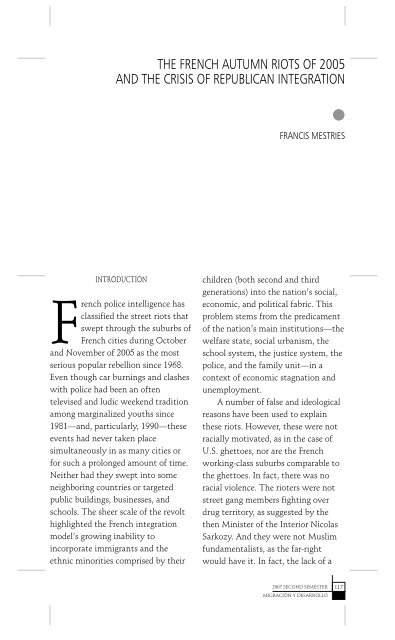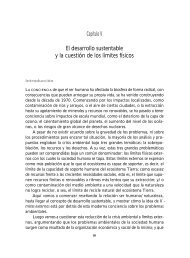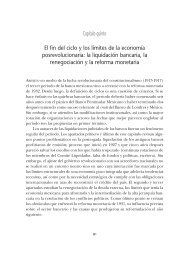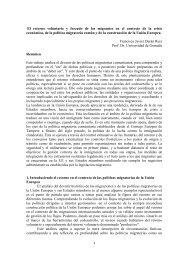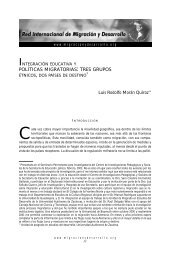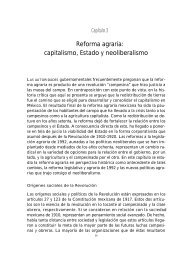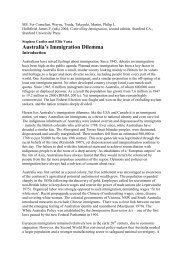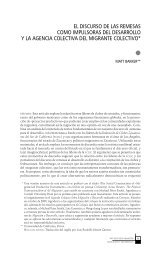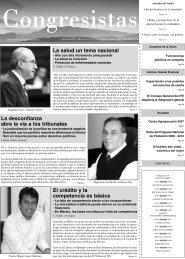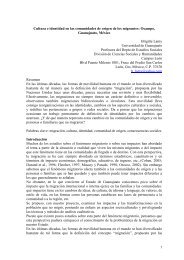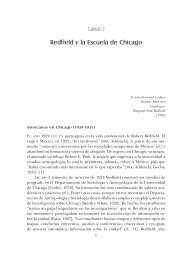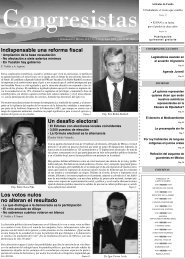the french autumn riots of 2005 and the crisis of republican integration
the french autumn riots of 2005 and the crisis of republican integration
the french autumn riots of 2005 and the crisis of republican integration
Create successful ePaper yourself
Turn your PDF publications into a flip-book with our unique Google optimized e-Paper software.
FRANCIS MESTRIESliberty, <strong>and</strong> equality. In fact, until <strong>the</strong>1990s, education provided someNorth African youths with <strong>the</strong> meansto achieve social ascent: <strong>the</strong>y becamepr<strong>of</strong>essionals, businessmen,technicians, etc., <strong>the</strong> so-calledBeurgeoisie 3 (Castles <strong>and</strong> Miller, 2004).A study addressing <strong>the</strong> educationalproblems <strong>of</strong> second generationimmigrants revealed that, despitehaving <strong>the</strong> highest failure rate <strong>of</strong> inprimary school, this populationbecame more pr<strong>of</strong>icient than <strong>the</strong>children <strong>of</strong> native French duringsecondary levels. This was due to <strong>the</strong>fact <strong>the</strong>ir families showed moreinterest in <strong>the</strong>ir educationalachievements <strong>and</strong> made use <strong>of</strong> <strong>the</strong>government’s special educationalassistance programs, which are meantfor students facing cultural difficulties(Lorcerie, 1999).There were attempts to institute abilingual <strong>and</strong> intercultural educationalpolicy during <strong>the</strong> late 1970s <strong>and</strong> <strong>the</strong>1980s; countries <strong>of</strong> origin financedlanguage <strong>and</strong> culture courses taught bynative teachers in an attempt t<strong>of</strong>acilitate <strong>the</strong> <strong>integration</strong> <strong>of</strong> immigrantchildren <strong>and</strong> adopt <strong>the</strong> multiculturalmodel favored in English-speakingcountries. This policy, however, wasnot implemented on a massive level<strong>and</strong> was quickly ab<strong>and</strong>oned when <strong>the</strong>children <strong>of</strong> immigrants became French.In <strong>the</strong> 1990s, this project gave way topolicies that attempted to balancequality st<strong>and</strong>ards through <strong>the</strong> use <strong>of</strong>educational aid <strong>and</strong> scholarships formarginalized areas, as well as <strong>the</strong>reinstatement <strong>of</strong> <strong>the</strong> notion <strong>of</strong> acommon culture (Lorcerie, ibid). Saidpolicies failed to curtail ethnicdiscrimination <strong>and</strong> pr<strong>of</strong>essionalsegregation, <strong>and</strong> <strong>the</strong> children <strong>of</strong> Africanimmigrants showed comparatively lessschooling: 71 percent <strong>of</strong> Algerians olderthan 15 had no diploma, <strong>and</strong> only 3.1per cent had finished high school orhad some kind <strong>of</strong> technical certificate(Zehraoui, 1999). There was also anoticeable educational “ghettoization”:<strong>the</strong> more immigrant children a givenschool had, <strong>the</strong> more neglected, lowquality,<strong>and</strong> violent it was, all <strong>of</strong> whichaccelerated <strong>the</strong> French Gaul exodus.This was compounded with <strong>the</strong>conflict over Muslim girls’ use <strong>of</strong> <strong>the</strong>veil, which was banned in order toenforce <strong>the</strong> non-religious <strong>and</strong> mixedcharacter <strong>of</strong> <strong>the</strong> French school system.This triumph on <strong>the</strong> part <strong>of</strong>conservative secularists only increasedexasperation among <strong>the</strong> Muslimminority.In fact, <strong>the</strong> school system isundergoing a pr<strong>of</strong>ound <strong>crisis</strong> thatincludes serious authority problems<strong>and</strong> lack <strong>of</strong> discipline; <strong>the</strong> intrusion <strong>of</strong>anti-social <strong>and</strong> delinquent behavior; agrowing inequality <strong>of</strong> resources <strong>and</strong>staff from one neighborhood <strong>and</strong>school to ano<strong>the</strong>r; programs <strong>and</strong>teachers who have failed to adapt toglobal realities, <strong>and</strong> early hyperspecialization.4 It is <strong>the</strong>refore not3From “Beur” (<strong>the</strong> verlan or French inverted slang term for “arabe”), which is <strong>the</strong> name given to<strong>the</strong> French children <strong>of</strong> North African immigrants.4In fact, admission to <strong>the</strong> gr<strong>and</strong>es écoles, or elite French schools, is even less democratic today thanit was twenty years ago.122SECOND SEMESTER 2007MIGRACIÓN Y DESARROLLO
THE FRENCH AUTUMN RIOTS OF <strong>2005</strong>surprising that many young banlieueinhabitants fail at school. Reeve(2006) quotes a unionized teacher:“You really believe in school because itis supposedly a tool for social ascent.Burning it down symbolically statesits ineffectiveness. You turn against itbecause it has disappointed you.”LABOR DISCRIMINATIONAND UNEMPLOYMENTThe workplace provides <strong>the</strong> mostinsight into <strong>the</strong> latent racismprevalent in French society. Foreignimmigrants have played a crucialeconomic role in <strong>the</strong> development <strong>of</strong>French industrialism since <strong>the</strong> early20th century: <strong>the</strong>y comprised asubmissive, cheap, <strong>and</strong> flexibleworkforce that adapted to economiccycles <strong>and</strong> cost little since it wasamenable to indirect salaries; manywere single men <strong>of</strong> productive agewho <strong>of</strong>ten returned to <strong>the</strong>ir country<strong>of</strong> origin when <strong>the</strong>y grew old.They worked in <strong>the</strong> public servicessector as well as <strong>the</strong> automotive,metallurgical, chemical, textile, <strong>and</strong>mining industries, among o<strong>the</strong>rs.They also took on menial jobs.Unfortunately (or not), <strong>the</strong> postindustrialrevolution led to a pr<strong>of</strong>oundindustrial restructuring <strong>and</strong>eliminated most low-qualificationjobs, as well as many <strong>of</strong> <strong>the</strong> sectors<strong>and</strong> productive branches in which<strong>the</strong>se migrants worked. Manyfound <strong>the</strong>mselves unemployed while<strong>the</strong> programs for legal labor migrationwere cancelled in 1974. Legalimmigration continued throughfamily reunification because, sincemigrants form <strong>the</strong>ir own families orbring <strong>the</strong>m from abroad, temporarycircular labor migration always givesway to permanent settling in <strong>the</strong>receiving country.The children <strong>of</strong> <strong>the</strong>se immigrantscould not take <strong>the</strong> jobs previouslyheld by <strong>the</strong>ir parents, nor were <strong>the</strong>yinterested in doing so. They had beeneducated in France, many werealready French, <strong>and</strong> <strong>the</strong>y wished tobreak away from <strong>the</strong> sub-proletariat.Few were able to do so because <strong>of</strong>general unemployment, <strong>the</strong>ir limitedaccess to higher education, <strong>and</strong>pervasive, latent discrimination. Theeconomic crises <strong>and</strong> <strong>the</strong> subsequentstagnation increased competitionamong lowly qualified French whites<strong>and</strong> <strong>the</strong> “new,” darker French withunpronounceable names <strong>and</strong>hybridized speech, who <strong>of</strong>ten lived in<strong>the</strong> same sordid neighborhoods. Thiscompetition based on <strong>the</strong> fear <strong>of</strong>“those who have come to take ourjobs” has played a crucial role in <strong>the</strong>exacerbation <strong>of</strong> racism <strong>and</strong> <strong>the</strong>popularity <strong>of</strong> <strong>the</strong> Front National, orNational Front (Castaingts, op. cit.).High unemployment rates havebeen a structural feature <strong>of</strong> Francesince <strong>the</strong> 1970s. They are <strong>the</strong> result<strong>of</strong> several institutional factors such asstringent labor regulations; highemployment taxes; <strong>the</strong> high costs <strong>of</strong>lay<strong>of</strong>fs vis-à-vis <strong>the</strong> increasingpopularity <strong>of</strong> temporary hiring; asegmented labor market; reducedlabor mobility, <strong>and</strong> lack <strong>of</strong> adjustmentin terms <strong>of</strong> workforce qualification,2007 SECOND SEMESTERMIGRACIÓN Y DESARROLLO123
FRANCIS MESTRIESamong o<strong>the</strong>rs (Pérez Pérez, 2006).Unemployment rates hovered above10 per cent for a long time <strong>and</strong>, in<strong>2005</strong>, <strong>the</strong>y were still at 9.8 percent,<strong>the</strong> European Union’s sixth worst rate(Pérez Pérez, ibid). The situation wasquite different in <strong>the</strong> United States<strong>and</strong> United Kingdom, whereunemployment rates were less thanhalf <strong>and</strong> all immigrants, legal or not,were able to find employment. InFrance, unemployment mostly affects<strong>the</strong> youth, people older than 55, <strong>and</strong>lowly qualified workers.The suburbs <strong>of</strong> large cities are <strong>the</strong>areas hardest hit by unemployment:21 percent <strong>of</strong> <strong>the</strong>ir population isjobless (<strong>the</strong> overall national average is10 per cent); in <strong>the</strong> nor<strong>the</strong>asternParisian banlieues where <strong>the</strong> <strong>riots</strong>began <strong>the</strong> rate is as high as 26 percent(Boils, 2006). Young Maghrebians areparticularly affected: in 1992,unemployed youths <strong>of</strong> Algerian origincomprised 40 percent <strong>of</strong> <strong>the</strong> nationalaverage, while <strong>the</strong> jobless children <strong>of</strong>native French amounted to 11percent. Not even educated beurscould find work: 26.5 percent <strong>of</strong>Algerian men <strong>and</strong> 36 percent <strong>of</strong> Algerianwomen were jobless in 1996(Zehraoui, 1999), <strong>and</strong> discriminationplayed an evident role in this(Tribalat, 1999). It is common foremployers to refuse applicants on <strong>the</strong>basis <strong>of</strong> skin color, surname, or place<strong>of</strong> residence. As <strong>the</strong> leader <strong>of</strong> <strong>the</strong>French employers association openlystated, “The culture <strong>of</strong> <strong>the</strong> banlieues isanti<strong>the</strong>tical to that <strong>of</strong> firms,” <strong>and</strong>children <strong>of</strong> immigrants are thought tohave difficulties adapting toworkplace discipline. In Clichy-sous-Bois, <strong>the</strong> area where <strong>the</strong> catalyticevents took place, unemployment hadreached 40 percent (Reeve, op. cit.).In such a context <strong>and</strong> with <strong>the</strong>welfare state in <strong>the</strong> midst <strong>of</strong> a financial<strong>crisis</strong>, subsidies <strong>and</strong> social education<strong>and</strong> health policies “are not enough tobring about social <strong>integration</strong>,”especially “when prejudice <strong>and</strong> racial,ethnic, or religious stigmatization limitaccess to employment” (RincónGallardo, <strong>2005</strong>).THE DEMOGRAPHIC IMPACTOF IMMIGRATION IN FRANCE.In 1999, 4, 310,000 <strong>of</strong> France’sresidents (or 7.4 percent <strong>of</strong> <strong>the</strong>national population) had been bornoutside <strong>the</strong> country. More than 1.5million immigrants had becomenaturalized in <strong>the</strong> previous decades,<strong>and</strong> half a million were coloredcitizens hailing from <strong>the</strong> so-calledDOM-TOM. 5 The main sendingcountries were Algeria (576,000),Portugal (570,000), Morrocco(521,000), Italy (380,800), Spain(316,500), Tunisia (201,700) <strong>and</strong>Turkey (176,000). France had Europe’slargest Muslim population: 2.5 millionin 1990, 5 million in 2007. Between1980 <strong>and</strong> 2000, approximately 545,000foreigners entered France legally eachyear, which amounted to just 0.01percent <strong>of</strong> a total population <strong>of</strong> 62.75Départements d’outre-mer, or Overseas Departments, <strong>and</strong> Territoires d’outre-mer, or Overseas Territories.124SECOND SEMESTER 2007MIGRACIÓN Y DESARROLLO
THE FRENCH AUTUMN RIOTS OF <strong>2005</strong>million in 2007. By <strong>the</strong> late 1990s <strong>and</strong><strong>the</strong> early 2000s immigrants werealmost twice that number. Over twothirds <strong>of</strong> <strong>the</strong>m were reuniting with<strong>the</strong>ir families, o<strong>the</strong>rs were marryingFrench citizens or seeking asylum,<strong>and</strong> only 12 percent were in Francefor work-related reasons (Le Monde,2006).Even though immigrant flow intoFrance is not massive, it nowcomprises 25 percent <strong>of</strong> <strong>the</strong> nation’sdemographic growth, which ischaracterized by low birth rates.Immigrants help counteract <strong>the</strong>accelerated ageing <strong>of</strong> <strong>the</strong> population<strong>and</strong> provide an economically activepopulation for <strong>the</strong> proximate future,as <strong>the</strong>y tend to have 35 percent morechildren than French families (Boils,op. cit.). Even though this does notpose an immediate threat to Gauldominion, immigrants’ high birthrates worry <strong>the</strong> right wing <strong>and</strong> exert atoll on social services.The European Union has anestimated 3 million undocumentedmigrants, 500,000 <strong>of</strong> which currentlyreside in France. The country receivesbetween 10 <strong>and</strong> 20,000 <strong>of</strong> <strong>the</strong>m eachyear (0.03% <strong>of</strong> <strong>the</strong> population). Mostare lowly qualified adult men whowork in <strong>the</strong> informal economy(domestic services, manufacture,construction, agroindustry, <strong>and</strong>agriculture) under conditions <strong>of</strong>exploitation or near-enslavement, orformally unemployed people whosurvive by working on <strong>the</strong> streets <strong>and</strong>engaging in small-time trafficking.These undocumented migrants, betterknown as <strong>the</strong> sans-papiers (or “withoutpapers”), staged several protestsduring <strong>the</strong> 1990s, participating inchurch takeovers <strong>and</strong> hunger strikes.They managed to achieve someregularization policies under socialistgovernments but, since 2002, <strong>the</strong>yhave been systematically hunteddown <strong>and</strong> deported. The Frenchgovernment has complained thatSpain <strong>and</strong> Italy tolerate cl<strong>and</strong>estinemigration that subsequently ends upin France.THE CRISIS OF INTEGRATION POLICIESThe youth <strong>riots</strong> in France’s urban <strong>and</strong>social periphery are <strong>the</strong> consequence<strong>of</strong> a worn out institutional systemthat has exhausted its economic <strong>and</strong>cultural assimilation capacities, but<strong>the</strong>y also owe much to increasinglytyrannical measures <strong>of</strong> politicalcontrol <strong>and</strong> police repression. “The<strong>crisis</strong> is that <strong>of</strong> French Republicanism:<strong>the</strong> French Republic tells everyone that‘liberty, equality, fraternity’ is awonderful promise, but it is not <strong>the</strong>refor everyone; <strong>and</strong> when you areyoung, educated, <strong>and</strong> you know that<strong>the</strong> school system is going to besegregated in actuality (<strong>and</strong> not justin <strong>the</strong>ory), this is going to be veryfrustrating. This is <strong>the</strong> only <strong>crisis</strong> <strong>of</strong>such magnitude in Europe, a generalinstitutional <strong>crisis</strong>: it applies to <strong>the</strong>justice system, <strong>the</strong> police, butparticularly to <strong>the</strong> school system”(Wieviorka, 2006).Indeed, social <strong>and</strong> politicalinstitutions are in <strong>crisis</strong>: <strong>the</strong> Frenchsocial welfare system, one <strong>of</strong> <strong>the</strong> most2007 SECOND SEMESTERMIGRACIÓN Y DESARROLLO125
FRANCIS MESTRIESadvanced in <strong>the</strong> world, already showsa big deficit in <strong>the</strong> pension <strong>and</strong> healthcoverage areas due to <strong>the</strong> ageing <strong>of</strong> <strong>the</strong>population <strong>and</strong> <strong>the</strong>ir anticipatedretirement. The courts are backloggedwith trials, disarmed in <strong>the</strong> face <strong>of</strong>delinquents who are too young to goto jail <strong>and</strong> whom <strong>the</strong> system does notknow how to h<strong>and</strong>le. The police lacksufficient resources to fight growingcrime, <strong>and</strong> families disintegrate asparents divorce, <strong>the</strong> gap betweenparents <strong>and</strong> children increases, <strong>and</strong>monoparental households becomeincreasingly common. Nationalcultural <strong>integration</strong> is threatened by<strong>the</strong> growing U.S. influence <strong>and</strong> <strong>the</strong>communal seclusion <strong>of</strong> ethnicminorities, who feel discriminatedagainst <strong>and</strong> seek to reaffirm <strong>the</strong>iridentity through religious conversion.This is <strong>the</strong> case <strong>of</strong> some Muslimcommunities whose religiousapproach sometimes takes an integristor political stance as a form <strong>of</strong> protest.On <strong>the</strong> o<strong>the</strong>r h<strong>and</strong>, racistattitudes <strong>and</strong> xenophobic politicalopinions boost <strong>the</strong> popularity <strong>of</strong> <strong>the</strong>Front National <strong>and</strong> o<strong>the</strong>r right-wingparties:The French Republic was <strong>the</strong> <strong>integration</strong>machine; when it broke down,all <strong>of</strong> its pieces stopped working atonce: <strong>the</strong> army, <strong>the</strong> family, <strong>and</strong> <strong>the</strong>school system, which were <strong>the</strong> elementsthat passed on patriotic culture.The same thing happened to <strong>the</strong>church, <strong>the</strong> political parties, <strong>and</strong> <strong>the</strong>unions. Rule <strong>of</strong> law cannot existwithout common values, since citizensidentify with <strong>the</strong>ir fellowsthrough models that do not currentlyexist. This is why unconscious, religious,or ethnically-based identitiessurpass <strong>the</strong> feeling <strong>of</strong> <strong>republican</strong> citizenship.… Vertigo <strong>and</strong> anarchic revoltsare an expression <strong>of</strong> frustration(Debray, <strong>2005</strong>, quoted in Cruz Zamorano,2006).And yet, <strong>the</strong> children <strong>of</strong> NorthAfrican immigrants did try tointegrate into French culture: manymarried native French citizens <strong>and</strong>were institutionally incorporated. TheFrench naturalization policies (whichprivilege jus soli over <strong>the</strong> blood rightsstill recognized in Germany) <strong>and</strong> <strong>the</strong>welcoming refugee programs werequite benevolent during <strong>the</strong> 1980s.Schools opened up to immigrants <strong>and</strong>tried to cater to <strong>the</strong>ir needs, but as <strong>the</strong>nation went into economic recession<strong>and</strong> unemployment grew, <strong>the</strong> children<strong>of</strong> immigrants were subjected togrowing racism <strong>and</strong> became “secondclass citizens: France has not beenable to integrate <strong>the</strong>m, nei<strong>the</strong>rsocially, politically, or economically”(Cruz Zamorano, ibid). These newFrench generations have been <strong>the</strong>victims <strong>of</strong> latent racism on all fronts:<strong>the</strong> educational system (<strong>the</strong> ban onveils in schools), <strong>the</strong> cultural space(discrimination in <strong>the</strong> private laborsector), housing (limited access toliving quarters), <strong>and</strong> political racism(racist attacks <strong>and</strong> hate crimes;Bataille, 1999).Lacking a cohesive familystructure <strong>and</strong> human <strong>and</strong> parentalmonetary capital, most <strong>of</strong> <strong>the</strong>m areunable to incorporate <strong>the</strong>mselves into<strong>the</strong> normative structures <strong>of</strong> <strong>the</strong>126SECOND SEMESTER 2007MIGRACIÓN Y DESARROLLO
THE FRENCH AUTUMN RIOTS OF <strong>2005</strong>middle class <strong>and</strong> are “assimilateddownwards” (Portes <strong>and</strong> De Wind,2006). They are also unable to join <strong>the</strong>transnational ethnic networks thatprovide youths with family <strong>and</strong>communal support, maintain culturalvalues <strong>and</strong> behaviors belonging to <strong>the</strong>country <strong>of</strong> origin, <strong>and</strong> create ethniclabor markets through which <strong>the</strong>ycould attain a modicum <strong>of</strong> economicwealth (García Borrego, 2006). In fact,most <strong>of</strong> <strong>the</strong>m have been acculturated.[According to Le Monde, in 1995]only 24 percent <strong>of</strong> children born toAlgerian parents speak <strong>the</strong>ir parentslanguage <strong>and</strong> only 14 per cent werepracticing Muslims, while 50 percent<strong>of</strong> Algerian children born in Francehad had <strong>the</strong>ir first relationship withnative French (Le Monde, 1995).Never<strong>the</strong>less, in <strong>the</strong> banlieues, thisacculturation has not resulted in acomplete adoption <strong>of</strong> French culture,which is considered “second class.”There, youths cultivate an“Americanized culture, that <strong>of</strong> hiphop’s gangsta rap: <strong>the</strong>y wear <strong>the</strong> sameclo<strong>the</strong>s, use <strong>the</strong> same gestures, play<strong>the</strong> same videogames, listen to <strong>the</strong>same music, <strong>and</strong> organize in gangsthat are similar to those in <strong>the</strong> UnitedStates” (Castaingts, op. cit.). In fact,<strong>the</strong>y are pushed toward a culture <strong>of</strong>violence.The great trap <strong>and</strong> paradoxinvolving <strong>the</strong> children <strong>of</strong> Africanimmigrants is that, even whenan individual integrates <strong>and</strong> becomesacculturated, “French society will stillconsider him inferior because he isdifferent, but he has already cut histies to his group <strong>of</strong> origin. He isdoubly guilty <strong>of</strong> treason: he is part <strong>of</strong>his group <strong>of</strong> origin without reallybelonging to it, <strong>and</strong> he is part <strong>of</strong> <strong>the</strong>receiving society without reallybelong to it” (Lapeyronnie, 1999).These youths find discriminationmore difficult to bear than <strong>the</strong>irparents because <strong>the</strong>y were born inFrance <strong>and</strong> no longer have ties toano<strong>the</strong>r place <strong>of</strong> origin; <strong>the</strong>y cannottake refuge in <strong>the</strong>ir roots (ibid) <strong>and</strong>, inresponse, try to build an identity thatexacerbates <strong>the</strong>ir difference. This,for example, is <strong>the</strong> case with radicalMuslims whose identity is based on<strong>the</strong>ir problematic experiences in <strong>the</strong>receiving society <strong>and</strong> acts as a dem<strong>and</strong>for recognition (ibid). Ultimately,<strong>the</strong>se approaches lead to clashes withpolice, reverse racism, <strong>and</strong> streetviolence.POLITICAL BACKGROUNDAND CAUSES OF THE RIOTSThe Parisian suburbs used to be <strong>the</strong>capital’s “red belt,” <strong>the</strong> area where <strong>the</strong>Parti Communiste Français (<strong>the</strong>French Communist Party, or PCF) hadsocial <strong>and</strong> political control. But,starting in <strong>the</strong> 1980s, <strong>the</strong> party grewso weak that it almost disappearedfrom <strong>the</strong> region, leaving a largeorganizational gap <strong>and</strong> a scarcity <strong>of</strong>social <strong>and</strong> housing policies. A largepart <strong>of</strong> <strong>the</strong> PCF’s base moved to <strong>the</strong>Front National, inaugurating <strong>the</strong>division between <strong>the</strong> native <strong>and</strong>naturalized French proletariats.During <strong>the</strong> 1980s, <strong>the</strong> frustration<strong>and</strong> belligerence latent among <strong>the</strong>2007 SECOND SEMESTERMIGRACIÓN Y DESARROLLO127
FRANCIS MESTRIESinheritors <strong>of</strong> migration was channeledtoward civic <strong>and</strong> political venues. In1983, under <strong>the</strong> socialist government<strong>and</strong> after <strong>the</strong> first suburban <strong>riots</strong>, alarge anti-racist movement brought<strong>the</strong> French public <strong>and</strong> beur youthstoge<strong>the</strong>r on a 100,000 person marchfrom Marseille to Paris. Thismovement insisted on equality at <strong>the</strong>same time that it dem<strong>and</strong>ed <strong>the</strong> rightto cultural difference, mixing<strong>republican</strong> ideals with communalforms <strong>of</strong> organization <strong>and</strong> culture(Wihtol de Wenden, 1999). Theundocumented immigrant protesterswanted to express <strong>the</strong>ir desire for akind <strong>of</strong> political conversation thatwent beyond full <strong>and</strong> participativecitizenship <strong>and</strong> addressed all levels,from <strong>the</strong> local to <strong>the</strong> national. Theyeven nominated c<strong>and</strong>idates formunicipal elections. They werereceived by former president FrançoisMitterr<strong>and</strong>, who provided some withresident status <strong>and</strong> ten-year workpermits <strong>and</strong> naturalized many o<strong>the</strong>rs.In exchange, <strong>the</strong> government <strong>and</strong> <strong>the</strong>socialist party attempted to takepolitical control <strong>of</strong> <strong>the</strong> movement.They co-opted its leaders <strong>and</strong> cut<strong>the</strong>m <strong>of</strong>f from <strong>the</strong>ir popular base, thusneutralizing <strong>the</strong> movement’s radicalpotential. The tradition <strong>of</strong> anticapitaliststruggle was lost after <strong>the</strong>defeat <strong>of</strong> <strong>the</strong> last immigrant workerstrikes, which did not connect to <strong>the</strong>urban protests carried out by <strong>the</strong>immigrant’s children or obtain <strong>the</strong>support <strong>of</strong> <strong>the</strong> unionized Frenchworkers (Dell’Umbria, 2006).By <strong>the</strong> 1990s <strong>and</strong> faced with <strong>the</strong>lack <strong>of</strong> political will on <strong>the</strong> part <strong>of</strong> <strong>the</strong>socialist government, which failed tointegrate <strong>the</strong>m into <strong>the</strong> politicalsystem, <strong>the</strong> beur activists had becomedisenchanted. The disappointment inboth <strong>the</strong> political left <strong>and</strong> <strong>the</strong> antiracistbeur movement, which had onlyfocused on one aspect <strong>of</strong> socialexclusion <strong>and</strong> had not solved <strong>the</strong>economic problems facing its youth,led to <strong>the</strong>ir loss <strong>of</strong> legitimacy <strong>and</strong> gaveway to Muslim associations, some<strong>of</strong> which followed communaltraditions <strong>and</strong> rejected <strong>integration</strong>:“<strong>the</strong> associative movement had torelocate or disappear” (Wihtol deWenden, 1999). The late 1990s saw<strong>the</strong> emergence <strong>of</strong> <strong>the</strong> sans-papiers’movement, which gained <strong>the</strong> support<strong>of</strong> French intellectuals, NGOs <strong>and</strong> <strong>the</strong>church, but did not achieve <strong>the</strong> kind<strong>of</strong> massive union between Frenchyouths <strong>of</strong> native <strong>and</strong> immigrant originthat had taken place in <strong>the</strong> 1980s.The process <strong>of</strong> sociocultural<strong>integration</strong> maintained it course,although new hybrid models—such asa type <strong>of</strong> cultural <strong>integration</strong> that didnot completely relinquish familyidentity—were adopted. Economicinsertion, on <strong>the</strong> o<strong>the</strong>r h<strong>and</strong>, wasnegatively affected by <strong>the</strong> highunemployment rate <strong>and</strong> this created afertile ground for differentialism <strong>and</strong>communitarism (Wihtol de Wenden,1999), along with spontaneousmanifestations <strong>of</strong> rage. Today “we nolonger have a worker’s (or citizen’s)movement, or a political party thatcan politicize <strong>the</strong> frustration <strong>and</strong> rageexperienced by <strong>the</strong>se youths, <strong>and</strong> <strong>the</strong>irrevolts take on a self-destructivetenor” (Noiriel, 2002).128SECOND SEMESTER 2007MIGRACIÓN Y DESARROLLO
THE FRENCH AUTUMN RIOTS OF <strong>2005</strong>The right-wing governmentalpolicies implemented by JacquesChirac <strong>and</strong> Sarkozy starting in 2002reduced <strong>the</strong> amount <strong>of</strong> socialprograms <strong>and</strong> increased repressive <strong>and</strong>security measures, amplifying <strong>the</strong>sense <strong>of</strong> moral wrong <strong>and</strong> injury.Locally subsidized youth employmentprograms, which hired secondgenerationbanlieue youths as socialmediators, were suppressed; <strong>the</strong>public health budget for impoverishedareas was reduced; economic supportfor neighborhood social workers wascancelled, <strong>and</strong> local police forces, whohad gained <strong>the</strong> trust <strong>of</strong> <strong>the</strong> residentsbecause <strong>the</strong>y lived in <strong>the</strong> sameproblematic areas, were disb<strong>and</strong>ed.This urban policy was limited to anincrease in policing activities <strong>and</strong> astance against terrorism <strong>and</strong>delinquency: youths were bannedfrom meeting around tower entrancesto “stop <strong>the</strong> creation <strong>of</strong> gangs” (or,more to <strong>the</strong> point, to keep <strong>the</strong>m fromthinking <strong>and</strong> acting collectively), <strong>and</strong>renovation programs in highlydeteriorated buildings wereab<strong>and</strong>oned, leading to accidents <strong>and</strong><strong>the</strong> death <strong>of</strong> 60 people. Race conflictsincreased <strong>and</strong>, two months before <strong>the</strong><strong>riots</strong>, a purportedly accidental fire in amigrants’ dwelling caused <strong>the</strong> death<strong>of</strong> 14 people, including two children.Similar fires had happened before,killing 24 Africans in <strong>the</strong> outskirts<strong>of</strong> Paris.In addition to a restrictiveimmigration policy <strong>and</strong> very toughsecurity measures, Sarkozyimplemented a U.S.-stylecommunitarian <strong>integration</strong> policy.He supported <strong>the</strong> building <strong>of</strong> mosques<strong>and</strong> recognized all Muslim leaders—including some integrist associationswithout much representation—aspolitical interlocutors in an attemptto control <strong>the</strong>m. France’s formerMinister <strong>of</strong> <strong>the</strong> Interior <strong>and</strong>,unfortunately, its current president,seems to derive more <strong>of</strong> his ideas fromAnglo-Saxon multiculturalism (whichhas been questioned <strong>and</strong> even partiallyeschewed in <strong>the</strong> United States) thanfrom <strong>the</strong> homogenizing, assimilationist,<strong>and</strong> lay <strong>republican</strong> model.SOME CLUES INTO THE MEANINGOF THE RIOTSThe <strong>riots</strong> were <strong>the</strong> marginalizedFrench youth’s dem<strong>and</strong> foracknowledgment, an affirmation <strong>of</strong><strong>the</strong>ir dignity <strong>and</strong> social <strong>and</strong> politicalbeing. They were a protest againstconstant police abuse, arrests basedon ethnic pr<strong>of</strong>iling, <strong>and</strong> “accidental”beatings <strong>and</strong> deaths that always gounpunished. These youths wanted tobe French citizens as much as anyoneelse, <strong>and</strong> enjoy <strong>the</strong> employment,consumption, cultural, <strong>and</strong>gratification rights <strong>the</strong>y cannot accessbecause <strong>of</strong> <strong>the</strong>ir race or origin. In <strong>the</strong>words <strong>of</strong> J. Railte, Seine St. Denis’communist senator, “The dem<strong>and</strong> <strong>of</strong>second generation youths is to enjoycomplete citizenship in <strong>the</strong>ir diversity,<strong>and</strong> not belong to this or thatcommunitarian, ethnic or religiousgroup” (<strong>2005</strong>). “What <strong>the</strong>y cannotbear is <strong>the</strong> breach between <strong>the</strong>ory <strong>and</strong>practice, between <strong>the</strong> motto <strong>of</strong>2007 SECOND SEMESTERMIGRACIÓN Y DESARROLLO129
FRANCIS MESTRIES<strong>republican</strong> equality <strong>and</strong> a destiny <strong>of</strong>unemployment. […] All <strong>the</strong>y dreamabout is having money so that <strong>the</strong>ycan consume like everyone else”(Bouzour, <strong>2005</strong>).The lack <strong>of</strong> criminal recordsamong <strong>the</strong> <strong>riots</strong>’ detainees invalidates<strong>the</strong> notion that <strong>the</strong>se revolts were <strong>the</strong>result <strong>of</strong> gang wars over drugterritory. The religious factor does notexplain <strong>the</strong>m ei<strong>the</strong>r, as <strong>the</strong> violencedid not have any sort <strong>of</strong> Muslimcomponent (Wieviorka, op.cit.); infact, some Muslim associations triedto create protection militias, whichwere repudiated by <strong>the</strong> rioters. Thesame happened with left-wingorganizations, which had nothing todo with <strong>the</strong> <strong>riots</strong>, did not foresee<strong>the</strong>m, <strong>and</strong> did not underst<strong>and</strong> <strong>the</strong>m.This can partially explain <strong>the</strong> lack <strong>of</strong> apolitical agenda in a movement where<strong>the</strong> only dem<strong>and</strong> ever (<strong>and</strong> onlyoccasionally) voiced was <strong>the</strong> removal<strong>of</strong> Sarkozy. This would also explain<strong>the</strong> absence <strong>of</strong> any sort <strong>of</strong> socialutopia or networks with o<strong>the</strong>r popularsectors. In any case, <strong>the</strong> targets <strong>of</strong> <strong>the</strong>rioters’ attacks leave little doubtabout <strong>the</strong> fact that <strong>the</strong>ir dem<strong>and</strong>s <strong>and</strong>ire were directed at <strong>the</strong> state.The sociodemographic <strong>and</strong>socioeconomic pr<strong>of</strong>ile <strong>of</strong> <strong>the</strong>se youthssheds light on <strong>the</strong> nature <strong>of</strong> <strong>the</strong>irmovement: 50 percent <strong>of</strong> detaineeswere underage, averaging between 14<strong>and</strong> 22 years <strong>of</strong> age—some weremerely 11. This explains, for example,<strong>the</strong> ludic character <strong>of</strong> <strong>the</strong> fires, whichwere set by unemployed teenagerswith no access to recreationalactivities. It also shows that <strong>the</strong>succession <strong>of</strong> <strong>riots</strong> partially resultedfrom acts <strong>of</strong> emulation, which werepropitiated by mass media coveragethroughout neighborhoods <strong>and</strong> cities:“let’s get on TV with more fires.”Thirty-two percent <strong>of</strong> detainees onlyhad primary education <strong>and</strong> manywere failing at school, which, inturn, explains <strong>the</strong>ir lack <strong>of</strong> educationalexpectations. Those who were notstudents <strong>and</strong> were held for trial hadprecarious <strong>and</strong> badly paid jobs: err<strong>and</strong>boys, carriers, movers, bakers, etc.(Jeremie, 2006). In short, <strong>the</strong>y werepart <strong>of</strong> <strong>the</strong> sub-proletariat.According to a 2006 survey carriedout by sociologist H. Lagrange, <strong>the</strong>neighborhoods that experienced <strong>the</strong>most violence during <strong>the</strong> <strong>riots</strong> shared<strong>the</strong> same main characteristics:• A high unemployment rate among<strong>the</strong> young.• A high underage population; children<strong>and</strong> teenagers could comprisemore than 35 percent <strong>of</strong> <strong>the</strong> population.• A very high rate <strong>of</strong> large families(over 6 people per family, especiallyamong immigrants from Sub-SaharanAfrica, who have many children <strong>and</strong>little money). This can lead to veryserious family problems, <strong>and</strong> 83 percent<strong>of</strong> <strong>the</strong> rioters lived in small welfareapartments: “They live on top <strong>of</strong>each o<strong>the</strong>r; when <strong>the</strong>y grow up <strong>the</strong>yhave problems with <strong>the</strong>ir siblings.Family income is quite reduced <strong>and</strong><strong>the</strong>re is no money left for entertainment(M. Lahtifi, educator, <strong>2005</strong>). Accordingto Lagrange, this explosivecombination is <strong>the</strong> most significantvariable.130SECOND SEMESTER 2007MIGRACIÓN Y DESARROLLO
THE FRENCH AUTUMN RIOTS OF <strong>2005</strong>• These are poor neighborhoods inrich cities, <strong>and</strong> <strong>the</strong> youths resent <strong>the</strong>social contrasts <strong>the</strong>y face on a dailybasis.• The housing complexes are extremelydeteriorated <strong>and</strong> waiting tobe demolished.• Black youths were overrepresentedamong <strong>the</strong> rioting population, afactor that could be linked to <strong>the</strong>problems caused by large families livingin small spaces (Lagrange, LeMonde, 2006).CONCLUSIONSThe <strong>2005</strong> <strong>riots</strong> can be seen as anexplosion <strong>of</strong> irrational rage involvingpsychological mechanisms <strong>of</strong> “stigmaretrieval” (Morice, op. cit.), a processwhere <strong>the</strong> victims <strong>of</strong> discriminationadopt <strong>the</strong> characteristics <strong>of</strong> <strong>the</strong>ascribed stigma <strong>and</strong> use <strong>the</strong>m as aform <strong>of</strong> vindication (e.g., thoseclassified as violent gang membersbecome more violent, thosedisparaged as native or black proclaim<strong>the</strong>ir indigenous character or <strong>the</strong>irblackness). This mechanism wasanalyzed by Frantz Fanon in histreatise on colonialism, The Wretched<strong>of</strong> <strong>the</strong> Earth.Ano<strong>the</strong>r possible interpretation isthat provided by Wieviorka, whorefers to floating subjects that cannotquite become actors <strong>and</strong> insert<strong>the</strong>mselves into a social, political, orintercultural relationship because <strong>the</strong>yfeel rejected <strong>and</strong> unrecognized assubjects. This can lead to angry <strong>and</strong>destructive or self-destructivebehaviors when an individual orano<strong>the</strong>r member <strong>of</strong> <strong>the</strong> group issubjected to abuse or injustice. Thisviolence can act as a cathartic toolthat tears <strong>the</strong> individual away from adaily state <strong>of</strong> passivity <strong>and</strong> alienation<strong>and</strong> can lead to a subjectivationprocess that, stemming from aspontaneous feeling <strong>of</strong> solidarity,could become <strong>the</strong> first step towardcivic, cultural, sportive, or politicalparticipation on <strong>the</strong> one h<strong>and</strong>, <strong>and</strong>delinquency <strong>and</strong> antisocial behavioron <strong>the</strong> o<strong>the</strong>r (Wieviorka, <strong>2005</strong>).These <strong>riots</strong>, however, can alsobe seen a pre-political <strong>and</strong> antiauthoritarian(ra<strong>the</strong>r thananti-capitalist) revolt that seeksrecognition, equal opportunities, <strong>and</strong>respect for difference in a society <strong>and</strong>state that exclude <strong>and</strong> humiliate <strong>the</strong>irbastard children after having exploited<strong>and</strong> marginalized <strong>the</strong>ir parents. Theviolence enacted by <strong>the</strong>se marginalsubjects represents both protection<strong>and</strong> freedom, at least for a while. “Theviolence <strong>of</strong> <strong>the</strong> subject is located in<strong>the</strong> lacks, <strong>the</strong> gaps, <strong>the</strong> decomposition<strong>of</strong> societal complexes on all levels,from <strong>the</strong> local to <strong>the</strong> global”(Wieviorka, <strong>2005</strong>).BIBLIOGRAPHYBATAILLE, Philippe (1999), “Racisme institutionnel,racisme cultural et discriminations,”Immigration et intégration:l’état des saviors, Paris, Edit. Dewitte,La Découverte.BODY-GENDROT, Sophie (1999), “Ghetto,my<strong>the</strong>s et réalités,” Immigration et Integration:l’état des saviors, Paris, Edit.Dewitte, La Découverte.2007 SECOND SEMESTERMIGRACIÓN Y DESARROLLO131
FRANCIS MESTRIESBOILS, Guillermo (2006), “Vivienda yexclusión social en la periferia deParís,” Revista de Investigación Social,Mexico, Instituto de InvestigacionesSociales, UNAM, no. 2, summer.BOUZOUR, Dounia (<strong>2005</strong>), “La religión notiene la culpa,” Mexico, Reforma,November 20.BRUNEAU, Michel (2004), Diasporas et espacestransnationaux, Paris, Anthropos.CASTAINGTS, Juan (<strong>2005</strong>), “Así vamos…Tumultos sociales en Francia,”El Financiero, México, November 17.CASTLES, Stephen <strong>and</strong> Mark Miller (2004),La era de la migración, Mexico, MiguelÁngel Porrúa, Instituto Nacional deMigración, Universidad Autónoma deZacatecas.CRUZ ZAMORANO, Alma Rosa (2006),“Francia, desempleo, inmigración yviolencia,” Mexico, Comercio Exterior,vol. 56, no. 4, April.DELL’UMBRIA, Alessi (2006), “C’est laracaille, eh bien, j’en suis,” Paris, Edit.L’Echappée.FANON, Frantz (1961), Les damnés de la terre,Maspero.GARCÍA BORREGO, Iñaki (2006), “Generacionessociales y sociológicas: un recorridohistórico por la literatura sociológicaestadounidense sobre los hijos deinmigrantes,” Migraciones Internacionales,Tijuana, Mexico, no.11, July-December.JEREMIE, Charles (2006), “A propos d’unerévolte populaire des cites,” CarréRouge, Paris, no. 35, March.LAGRANGE, Hugues (2006), “On peut lire lesviolences comme une dem<strong>and</strong>e d’Etatde la jeunesse,” Paris, Le Monde, June 7.LAPEYRONNIE, Didier (1999), “De l’altérité ala difference. L’identité, facteur d’intégrationou de repli?,” Immigration etIntégration: l’état des savoirs, Paris, Edit.Dewitte, La Découverte.LE MONDE (2004), “Les R.G. s’alarmentd’un repli communautaire dans lesbanlieues,” Paris, July 5.(2006), “L’immigration en Europe:durcissement quasi général,” Paris,June 7.LORCERIE, Francoise (1999), “La scolarisationdes enfants de migrants: faussesquestions et vrais problèmes,” Immigrationet Intégration: l’état des savoirs,Paris, Edit. Dewitte, La Découverte.MORICE, Alain (<strong>2005</strong>), “Les émeutes urbainesd’octobre-novembre <strong>2005</strong> en France:comprendre avant de juger,” electronicjournal Pajol,http//pajol.eu.org/article905.html.NOIRIEL, Gerard (2002), “Petite histoire del’intégration a la française,” Manièrede Voir No.62, Paris, Le Monde Diplomatique,March-April.PÉREZ PÉREZ, Gabriel (2006), “El problemadel trabajo y el estado de bienestar enla Unión Europea,” Mexico, El Cotidiano,no.136, March-April.PORTES, Alej<strong>and</strong>ro <strong>and</strong> Josh De Wind(2006), “Un diálogo trasatlántico: elprogreso de la investigación y la teoríaen el estudio de la migración internacional,”Repens<strong>and</strong>o las migraciones, inAlej<strong>and</strong>ro Portes <strong>and</strong> Josh De Wind(eds.), Mexico, Miguel Ángel Porrúa,Universidad Autónoma de Zacatecas,Instituto Nacional de Migración.QUIMINAL, Ca<strong>the</strong>rine (1999), “Les Africains,divers et dynamiques,” Immigrationet Intégration: l’état des savoirs,Paris, Edit. Dewitte, La Découverte.RALITE, Jack (<strong>2005</strong>), Intervention au Sénatsur le projet de loi prorogeant l’applicationde la loi No.55-385 du 3 avril 1955,November 16.REEVE, Charles (2006), Incendies sans paroles,Paris, Carré Rouge, no.35, March.REY, Henri (1999), “La peur des banlieues,”Immigration et Intégration: l’état des sa-132SECOND SEMESTER 2007MIGRACIÓN Y DESARROLLO
THE FRENCH AUTUMN RIOTS OF <strong>2005</strong>voirs, Paris, Edit. Dewitte, La Découverte.RINCÓN GALLARDO, Gilberto (<strong>2005</strong>), “Enseñanzafrancesa,” Mexico, Reforma,November 12.TODD, Emmanuel (1994), Le destin des immigrés,Paris, Seuil.TRIBALAT, Michele (1999), “Définir, quantifier,sérier les mécanismes d’intégration,”Immigration et Intégration: l’étatdes savoirs, Paris, Edit. Dewitte, La Découverte.WIEVIORKA, Michel (<strong>2005</strong>), La Violence,Paris, Hachette Littératures, Pluriel.(2006), Interview, Mexico,Departamento de Sociología,UAM-Azcapotzalco, October 20.WIHTOL DE WENDEN, Ca<strong>the</strong>rine (1999), “Lesjeunes issus de l’immigration entreintégration culturelle et exclusionsociale,” Immigration et Intégration :l’état des saviors, Paris, Edit. Dewitte,La Découverte.ZEHRAOUI, Ahsene (1999), “Les Algériens,de la migration a l’installation,”Immigration et Intégration : l’étatdes saviors, Paris, Edit. Dewitte,La Découverte.2007 SECOND SEMESTERMIGRACIÓN Y DESARROLLO133


